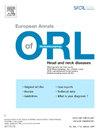成人颞骨脑脊液漏隔离或非隔离手术后 6 个月的疗效:STROBE 分析。
IF 1.9
4区 医学
Q2 OTORHINOLARYNGOLOGY
European Annals of Otorhinolaryngology-Head and Neck Diseases
Pub Date : 2024-11-01
DOI:10.1016/j.anorl.2024.07.002
引用次数: 0
摘要
目的:本研究的主要目的是评估孤立或非孤立颞骨骨膜破损(OMB)手术的6个月闭合成功率。次要目的是分析闭合的并发症以及成功率与破损、治疗和患者数据之间的相关性:这是一项单中心回顾性观察研究,研究对象是2007年至2022年间在法国一所大学教学医院通过中颅窝或经乳突入路接受颞骨OMB手术的患者,随访时间至少6个月。上半规管开裂患者除外。研究数据包括性别、年龄、体重指数、OMB病因、发现方式、听力和放射学数据、手术技术、住院时间和术后并发症。主要终点是6个月后核磁共振检查无脑脊液漏。定性数据采用费舍尔精确检验或Chi2检验,定量数据采用学生t检验:结果:闭合成功率为 87%:结果:闭合成功率为 87%:中颅窝组 16 名患者的闭合成功率为 81%(3 例复发),经乳突组 14 名患者的闭合成功率为 93%。术后听力测定显示,中颅窝组患者的气导显著改善(P=0.0016)。5名(17%)通过中颅窝入路手术的患者和1名(7%)通过经乳突入路手术的患者出现了术后并发症。8名患者(29%)的OMB位于蝶骨乳突,7名患者(25%)的OMB位于鼓膜蝶骨,4名患者(14%)的OMB位于蝶骨前突,3名患者(11%)的OMB位于蝶骨前突和鼓膜,1名患者(8%)的OMB位于鼓膜前突和乳突,5名患者(18%)的OMB位于整个蝶骨。11例OMB位于上半规管外侧,13例位于内侧,4例位于两侧:结论:经乳突入路适用于伴有中耳手术、年龄超过75岁或OMB位于上半规管外侧的患者。中颅窝入路适用于上半规管内侧的 OMB,年龄在 75 岁以下且无相关听骨手术的患者。对于上半规管内侧的 OMB 患者,如果需要进行中耳手术,可以采用联合入路。本文章由计算机程序翻译,如有差异,请以英文原文为准。
Outcomes at 6 months after isolated or non-isolated surgery for temporal bone cerebrospinal fluid leak in adults: A STROBE analysis
Aim
The main aim of this study was to evaluate 6-month closure success in surgery for isolated or non-isolated temporal bone osteomeningeal breach (OMB). Secondary objectives were to analyze complications of closure and correlations between success and breach, treatment and patient data.
Material and method
This was a single-center retrospective observational study of patients who underwent surgery for temporal bone OMB via a middle cranial fossa or transmastoid approach in a French university teaching hospital between 2007 and 2022, with follow-up of at least 6 months. Patients with superior semicircular canal dehiscence were excluded. Study data comprised gender, age, body mass index, OMB etiology, mode of discovery, audiometric and radiological data, surgical technique, length of hospital stay and postoperative complications. The primary endpoint was absence of a cerebrospinal fluid leak on MRI at 6 months. Fisher's exact test or Chi2 test were used for qualitative data and Student t-test for quantitative data.
Results
The closure success rate was 87%: 81% (3 recurrences) in the middle cranial fossa group of 16 patients and 93% in the transmastoid group of 14 patients. Postoperative audiometry showed significant improvement (P = 0.0016) for air conduction in the middle cranial fossa group. Five patients (17%) operated on via the middle cranial fossa approach and 1 (7%) operated on via the transmastoid approach had postoperative complications. OMB was in the tegmen mastoideum in 8 patients (29%), tegmen tympani in 7 (25%), tegmen antri in 4 (14%), tegmina antri and tympani in 3 (11%), antri and mastoideum in 1 (8%) and in the whole tegmen in 5 (18%). Eleven OMBs were lateral to the superior semicircular canal, 13 medial and 4 on either side.
Conclusion
The transmastoid approach is indicated in case of associated middle-ear procedures, patients aged over 75 years or OMB lateral to the superior semicircular canal. The middle cranial fossa approach is reserved for OMB located medial to the superior semicircular canal patients under 75 years of age without associated ossicular procedures. For patients with OMB medial to the superior semicircular canal who require middle-ear surgery, a combined approach can be used.
求助全文
通过发布文献求助,成功后即可免费获取论文全文。
去求助
来源期刊

European Annals of Otorhinolaryngology-Head and Neck Diseases
OTORHINOLARYNGOLOGY-
CiteScore
3.70
自引率
28.00%
发文量
97
审稿时长
12 days
期刊介绍:
European Annals of Oto-rhino-laryngology, Head and Neck diseases heir of one of the oldest otorhinolaryngology journals in Europe is the official organ of the French Society of Otorhinolaryngology (SFORL) and the the International Francophone Society of Otorhinolaryngology (SIFORL). Today six annual issues provide original peer reviewed clinical and research articles, epidemiological studies, new methodological clinical approaches and review articles giving most up-to-date insights in all areas of otology, laryngology rhinology, head and neck surgery. The European Annals also publish the SFORL guidelines and recommendations.The journal is a unique two-armed publication: the European Annals (ANORL) is an English language well referenced online journal (e-only) whereas the Annales Françaises d’ORL (AFORL), mail-order paper and online edition in French language are aimed at the French-speaking community. French language teams must submit their articles in French to the AFORL site.
Federating journal in its field, the European Annals has an Editorial board of experts with international reputation that allow to make an important contribution to communication on new research data and clinical practice by publishing high-quality articles.
 求助内容:
求助内容: 应助结果提醒方式:
应助结果提醒方式:


